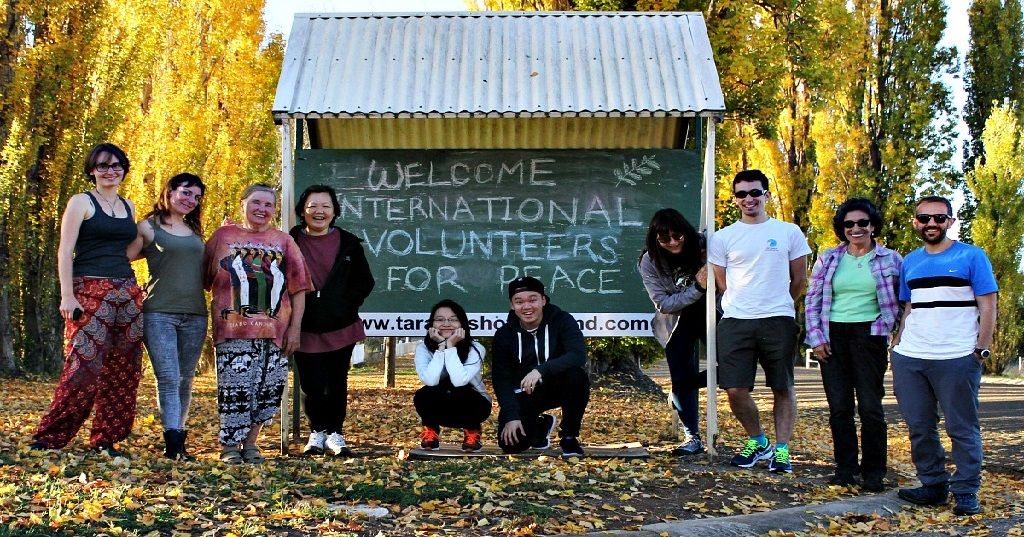by Rita Sofea Warleigh
Service Civil International began in Sydney in 1988. The International Coordinator of SCI wrote a letter to six people in Australia who had workcamp experience, suggesting that they start SCI in Australia.
I had done a workcamp in 1987 in Italy. There I discovered the SCI philosophy and was very inspired. Prompted by the SCI letter, I organised a meeting at Badde Manors Café in Glebe, Sydney, which was attended by Chris Dunstan and Vern Cork. Chris had done workcamps in Russia and Eastern Europe in 1987. Vern had done workcamps ten years previously and been a medium term volunteer for SCI in Bangladesh. For the past ten years Vern had acted as the Australian ‘contact’ for SCI, passing on the address of SCI in the relevant country to anyone who enquired. At this historic meeting, we three agreed to create SCI Australia.
None of us knew how to run an organisation but we were keen. We began communicating with SCI International Secretariat, which was at that time in Bangalore, India. We called our organisation Service Civil International, Australia. We decided from the outset that the organisation would be non-hierarchical, use consensus decision-making, and follow the principles of non-violence in the way we operate. In other words, we committed to learning cooperation and peace-building within the organisation as well as in the work we carried out. On the 6th October the first official records began, with minutes of meetings and financial transactions. We later discovered that one of the six Australians contacted by SCI had run a workcamp some years previously in Australia.
Chris and I organised the first workcamp in the Blue Mountains in December 1988. There were eleven volunteers, nine from overseas and two from Australia, with Chris and I as co-leaders. The main work was bush regeneration at Echo Point, Katoomba and at the Conservation Hut, Wentworth Falls. The volunteers also constructed a children’s playground outside the Women’s Health Centre in Katoomba. An Outreach program with the National Trust provided teachers for a weekend workshop in bush regeneration which was open to the public. This was a way of skilling the volunteers as well as interacting with the locals and publicising SCI.
Accommodation was at a communal property at Bell and transport to and from work was by means of my old Kombi. As we had no funding we charged the volunteers a small amount to participate. At the end of the workcamp we had a small deficit, solved by holding an open-day for the public and asking for donations. At this point, we also decided to begin memberships and established a membership register and bank account.
Straight after the workcamp, I went to Europe on a family matter and while there, I was lucky enough to catch three wonderful SCI events. The first was an international SCI meeting and the second an inspiring SCI seminar in the Netherlands, “Volunteering as a Way of Life”. Then I went to Verdun, France, to take part in the celebration of 70 years of SCI with the opening of the world’s first Peace Museum at the site of the first workcamp. There were SCI activists aged from 18 to 94 at this event, and I felt that I had found my ‘world family’.
In March 1990 we held a workcamp at Cattai State Recreation Area with National Parks and Wildlife Service. We planted two thousand trees under the guidance of Greening Australia. For accommodation we negotiated with the Richmond Army base who sent a team of soldiers to erect two enormous tents within the park. We set up a kitchen in one of the picnic huts with all kitchenware supplied by St Vincent de Paul.
In May, we rented our first office, a tiny space in a large open warehouse in the city, sharing with ten other NGOs including Friends of the Earth, Movement Against Uranium Mining, Black Deaths in Custody and Men Opposed to Patriarchy. From the workcamp in 1990 we gained a new member on the committee, Jane Fisher. Vern Cork had retired from IVP by this time. We began to produce an annual Workcamps Handbook and various newsletters. We also began to process applications from Australians wanting to go to workcamps overseas, setting the application fee at $60, $50 concession, and $40/30 for Australian workcamps. The ‘Flying Penguin’ logo was designed by Amanda Rees.
Another bush regeneration workcamp was held at Cattai in 1992. The same year, the office moved to Rita’s house in Katoomba and Derek Bissell became our Bookkeeper. In May 1992, SCI Australia changed its name to International Volunteers for Peace. We wrote a constitution and became incorporated with the Department of Fair Trading. We began fundraising by organising a concert with the popular gospel choir Café of the Gate of Salvation. The Café supported IVP through such concerts for five or six years. The same year the number of active volunteers had increased to about six and we saw a need to move the office back to Sydney in order to attract more members. We moved to our current address in a building owned by People for Nuclear Disarmament.
In 1993 we had our first workcamp with Push and Power State Wheelchair Games which was run by the Crippled Children’s Association. Volunteers acted as referees and line keepers, as well as some personal care and social interaction. These workcamps, probably more than any others, changed lives and hearts of our volunteers. These workcamps ran for four years and through them began our association with Kinma, an independent school at Terrey Hills which we used for accommodation, training and evaluation before and after the Games. When the State Wheelchair Games ceased, we began holding workcamps at Kinma, doing maintenance on the buildings and grounds. These were eventually moved to take in one week of the school term, so that the volunteers could interact with the children, giving language, cooking and geography lessons.
About this time we made a commitment to working with Aboriginal groups, people and communities. As part of the mandate of IVP is to dismantle racism, we felt that it was important to shine some light on the issues close to home. In 1993 we held our first workcamp taking disadvantaged urban Aboriginal children for a farm holiday at Goulburn Yurtfarm. These continued for several years and developed to later workcamps with Redfern Aboriginal groups and the Waterloo Police and Community Youth Club. In 1995 we held a workcamp at Clairvaux Community Centre, Katoomba and so began our long relationship with Gundungurra Tribal Council.
In 1994 we held our first Workcamp Leader Training and began holding Info-Nights and stalls at universities.
Another workcamp organisation formed in 1996. They were called AVP (Australian Volunteer Projects) and were a breakaway group from CWCA (Christian Work Camps Australia) which collapsed the same year. AVP organised a workcamp at Shalom College, a non-government school for Aboriginal and Torres Strait Island students. IVP collaborated by finding and processing volunteers. The following year AVP dissolved in favour of IVP taking over planning and running the Shalom workcamps. These continued with one or two camps every year for 10 years.
In 1997, I was invited to take part in a workcamp in Inner Mongolia and a seminar to set up a new network NVDA (Network for Volunteers in Asia). In 1998 we took on our most political workcamp, supporting the Mirrar people of Kakadu in their efforts to stop expansion of a uranium mine on their land. As you may know, this was a historic victory for the Mirrar, the mine was never opened, the exploratory shafts were filled in and the land regenerated. Several other one-off workcamps were with Ripple Effect, a sustainable energy group in the Blue Mountains, and with Heart Centre, a Buddhist retreat in Berowra, Sydney. In 1999, we held our first workcamp with Landcare in Lithgow and Bathurst and these continued for several years.
We worked hard on getting stories into local papers, but in about 1996 we had an article in Cosmopolitan. The resulting number of enquiries forced us revise our systems. Around this time we acquired our first computer, got an email address and computerised our membership data. In 2001 our website was created. This is now the main source of people finding out about IVP whereas previously it was by word-of-mouth.
2002 was the International Year of Volunteering. For the first time we succeeded in getting a grant of $5000 which paid for some beautiful publicity material. These were a post card through Avant Card, and matching brochures and Workcamps Handbook cover in colour. We were lucky to have a wonderful graphic artist volunteering with us at the time. The photos used were from Shalom Aboriginal College.
Two other important events this year were that we upgraded our status with SCI from Contact to Group and were also declared to be part of the Asian Region of SCI. The second event was that we had outgrown our tiny office, and moved to a bigger room in the same building, acquired several more computers and a network.
Also this year, we were fortunate to have Giovanna and Renzo, two active members of SCI Italy, arrive in Melbourne for a 5-year stay. Giovanna organised a workcamp in Melbourne with CERES for the Return of the Sacred Kingfisher Festival and these ran every year for five years. Through the NVDA network, we were approached by a Japanese tertiary institution and started to organise ‘bi-lateral workcamps’ with NICE Japan. These we ran in conjunction with Gundungurra Tribal Council in Katoomba.
A big boost for IVP came with the employment of a paid administrator for 15 hours a week. This made us much more professional and able to respond to communication efficiently and consistently. We were lucky to have Janet McKay who was not only excellent with administration but was studying Community Development so had a good understanding of the needs of an organisation like IVP. Janet moved on to study music full-time and shortly afterwards, in 2006, IVP suffered a financial downturn that forced us to return to full volunteer operation.
Over the years we have had volunteers come to stay with us for extended periods and these include Olivier and Ysabeau from France, Joachim from Sweden, Alan from WA. Lots of fabulous volunteers have worked in the office, gone on workcamps, and come to our workcamps.


